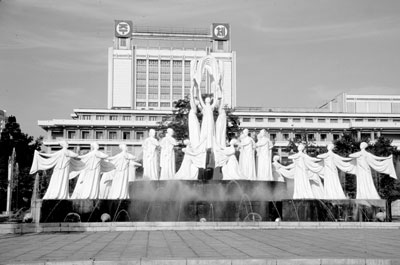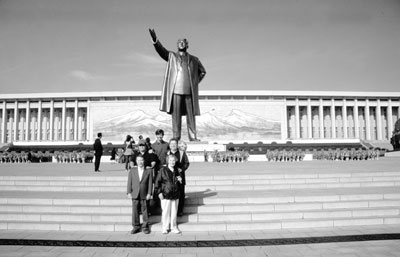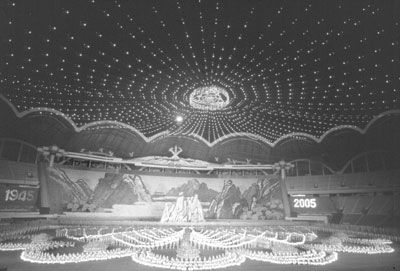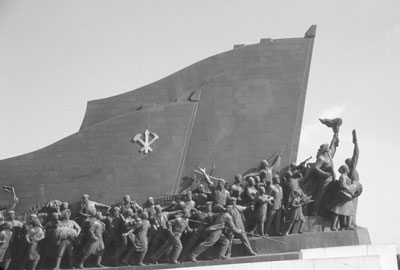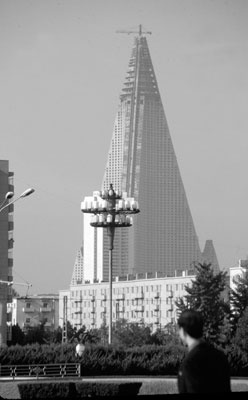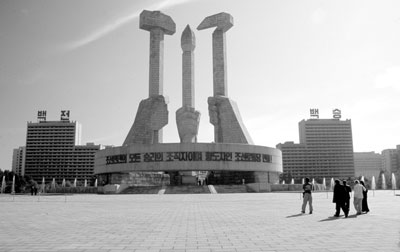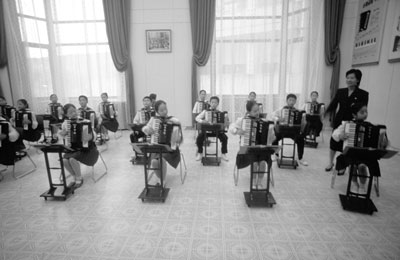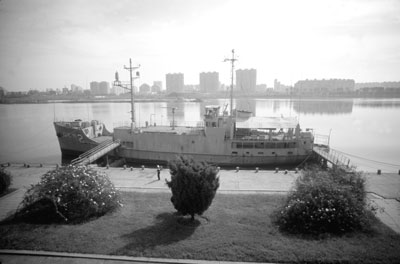A rare look into North Korea
In early October ’05, I learned that North Korea, otherwise known as the Democratic People’s Republic of Korea, had begun allowing Americans to obtain tourist visas. As North Korea had long been closed to Westerners, I jumped on the opportunity and signed up for a tour, Oct. 7-15, with Universal Travel System (Box 7050, Santa Monica, CA 90406; 800/255-4338 or www.uts-travel.com).
Along with a buddy, I made my way to Beijing, China, where, after a 3-day process, we received our visas from the North Korean Embassy. If we had not previously been screened by their government a year earlier for a trip the North Korean government had then canceled for no apparent reason, the visa process probably would have been more difficult.
We joined the remaining three tour members and boarded a Russian jet for our 2-hour flight to P’yongyang, North Korea. In addition to our small group of paying tourists, the plane was packed with journalists from all over the world, all abuzz with the excitement of a rare visit to this mysterious country.
We landed at a modern, very clean terminal where, on entry (as well as on our subsequent exit from North Korea), the officials refused to stamp our passports. Before leaving the terminal, we relinquished our cell phones with the promise that they would be returned to us at our departure.
We then drove out onto a modern highway that took us by hundreds of ultramodern buildings made of granite and marble.
Our first stop was the state circus, where we were treated to an excellent performance. Upon leaving, we noticed that it had become very quiet and dark on the streets of P’yongyang. We were taken to the area called Restaurant Row for a meal that was good, as were all of our meals during our stay.
After dinner, we were deposited in the elegant, 3-story lobby of the Koryu Hotel, a solid 5-star property. The hotel was actually two 45-story towers, each topped with a revolving restaurant. Modern escalators on both sides of the marble-inlaid floor of the lobby led up to a restaurant and shop and down to a basement complete with swimming pool and all of the amenities.
Our rooms were very modern, large and clean. We found that our TVs could receive one station during the week; it broadcast a continuous program of revolutionary themes. On the weekend, a second station was available with more of the same. The hotel had no Internet service.
My first impression that day, which did not change throughout our short visit, was that I felt very comfortable and safe in P’yongyang. No area that we saw there, or saw later as we toured away from the city, had any slum or rough area to avoid after dark. What other city in the world can claim that?
All that night, as was true every night of our stay there, we could hear melodic music being broadcast hourly from the railroad station; it was very pleasant. Each morning at 7:00 we were awakened by a loud air-raid siren. On the first day, from my room 30-plus stories up, I looked down at the people beginning to stir on the streets and saw a child alone on a park swing.
Later that first morning our local guide, Jong, along with the government official who would also accompany us on our outings, met us in the lobby. Jong informed us that we were going to have a lot on our plate during the next four days, since we would be seeing as much as could possibly be crammed in. He said, “Don’t complain about it!”
His warning was prophetic. I was soon overwhelmed by the stimuli I was receiving from this truly foreign land. It was as different and unfamiliar to me as if I had landed on Mars and was experiencing Martian culture for the first time.
Our first stop that day was at the monument to Kim Il Sung, the Great Leader, where flowers were an obligatory offering. No bronze or marble had been spared in the creation of this monument. The sculptures were as fine as any in classical Europe.
Kim’s son, Kim Jong Il, is the General and Dear Leader of North Korea. His portrait, in the form of a red pin, adorns every citizen of the country. He is the author of the Juche Idea, a philosophy that covers all aspects of life. He even created a calendar that is unique in the world — year number 1 is the Great Leader’s year of birth, and each year begins on his birthday.
The Dear Leader wears many hats. We were told that he was also the architect responsible for the design of P’yongyang, a very well-planned city. Within its limits, there must be half a dozen giant stadiums, each capable of holding 120,000 people. There are at least a dozen galleries and an equal number of different types of museums throughout the city.
In the Fatherland Liberation War Museum, we were shown jars of what was purported to be American nerve gas and germ warfare. One section of this massive museum was devoted to the American involvement in the Korean War. Dozens of American tanks, destroyed warplanes and crashed helicopters occupied the basement. Also on display were 15 Russian MiGs which had been used by North Korea during the war.
A large model of the infamous ship USS Pueblo was on display. Later that day we visited the Pueblo itself at its permanent anchor on the river. Originally a war prize, it is now a museum.
After watching a propaganda film, we were given a tour of the ship, where over 80 Americans had been captured and held prisoner. Jong, with four of our cameras draped around his neck, photographed us there. In a rare display of humor, he said, “After I take these pictures, I am going to throw these cameras in the river!”
Eighty-four percent of the North Korean landscape is mountainous. The word p’yongyang means “flat land.”
The second night, we left the “flat land” and drove north, almost to the Chinese border. There, the highway came to an abrupt dead end at the base of a modern, 20-story, pyramid-shaped hotel, our lodgings for the night. Early the next morning I watched perhaps 150 soldiers in brown uniforms marching past the hotel. Taking their picture would have gotten me in big trouble.
The main reason for our visit to this beautiful, rustic countryside was to see the International Friendship Hall. It is actually two dramatic buildings sitting side by side, about 90% underground. In these buildings are displayed the countless gifts given to the Great Leader as well as the Dear Leader by other countries, world leaders and famous figures and organizations over the years.
Allowing one minute per exhibit, it would take a year and a half to view all of the exhibits in the 200-plus rooms in the long, high, subterranean halls. We walked for miles underground, viewing gifts from over 170 countries, including a soccer ball from Pelé, a silver bowl from Madeleine Albright and four cars from Stalin’s armored train.
Back in the capital city, we visited its Arch of Triumph, which outsizes its counterpart in Paris. P’yongyang also has the highest stone tower in the world, which is adorned with a torch at the top.
At the other end of the spectrum, we descended into the deep tunnel that leads to the metro. The tunnel was designed to do double duty as a bomb shelter. The metro itself was old but in perfect condition and without graffiti. The seats may have been made of old Naugahyde, but they were pristine.
We visited a giant stadium constructed along the Puthong River, which bisects the city, to see the Arirang, the mass games held every couple of years to commemorate significant anniversaries. These games are huge, choreographed celebrations that are beyond imagination. Acrobats soared hundreds of feet across the stadium. My jaw dropped every time I looked up. The spectacle dwarfed any Olympic opening ceremony I have seen.
These performers, like their fellow countrymen, appear to be the most disciplined people on the face of the Earth. They would have made Hitler proud. The backdrop to the performance was a group of 50,000 children holding up color-coded cards in precise unison.
On the last day of our tour, we drove to Kaesong, site of a major battle in the Korean War, and also to the DMZ at Panmunjom to see the tightest border in the world. Having taken the DMZ trip years ago from the south via Seoul, the north side seemed very relaxed in comparison. However, along the road driving south from P’yongyang, I saw many tall towers designed to stop tanks.
At the beginning of the trip, we had decided as a group that we would encourage our guides to share their genuine feelings with us. What did we learn? The best way to put it is that they hate the American government 10 times more than the Jews hate the Nazis. They have one common enemy: us!
Their animosity toward us is constantly reinforced in museums and monuments that portray the U.S. negatively. During our stay, we were always referred to as “imperialists,” and South Koreans were referred to as “puppets.” There was never any point in arguing with this view. Jong and the state national guides have been taught, and firmly believe, that we Americans are responsible for all of the shortcomings that exist in the DPRK.
When someone in our group mentioned the prosperity in South Korea, Jong replied that North Korea is rich in cultural development. He commented in turn on the phenomenon of American students shooting their teachers, something incomprehensible in his culture.
We had arrived in the DPRK one day after an important anniversary, the 60-year celebration of the creation of North Korea. It had been marked by countless soldiers goose-stepping through Kim Il Sung Square. This military image is often the only view that the outside world, through the news network, receives of North Korea. We got a very different view, including an exhibition of flowers presented to the Dear Leader from across North Korea.
In this communist, totalitarian country, there were gift shops at every local “tourist site.” In the city, every man wore a dark suit. It is a very conservative culture, with many women in the city still wearing the chi ma jogury, a traditional kimono-style dress.
Our visit had included an excellent musical review at the Children’s Palace. There, children are taught arts and crafts as well as how to play most musical instruments.
After we returned to the States, the North Korean government unfortunately reversed its policy again, once more refusing to issue tourist visas to Americans. While this restriction is in place, we will see only military images of this fascinating country. I am glad that I was able to experience its other side for a few days.
With this trip, I had visited all of the world’s capitals. After seeing North Korea, however, the thought of visiting anyplace else seems anticlimactic.
BILL ALTAFFER
Mammoth Lakes, CA
Mr. Altaffer is returning to North Korea in 2006, leading the Sept. 30 departure of a tour with Universal Travel System. In addition to visas ($190), costs are as follows: land portion, sharing, $3,460; single room supplement, $750; Los Angeles-Beijing airfare, $2,923 business class or $1,015 economy class, plus Beijing-P’yongyang-Beijing airfare of $500.
ITN reported in the January ’06 issue, page 122, that Bill Altaffer had just “become” the most traveled man in the world, according to www.mosttraveledperson.com. He held that position for about four months until Charles Veley reclaimed it.

